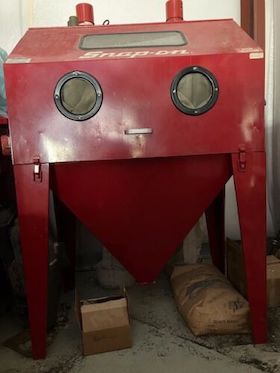
-----
Steelcase Tanker Desk Restoration Tips
Q. I have a desk exactly like the one in Mutt Lee's posting but in light gray with a black top. I found the desk July of last year out in the country along the highway with a free sign on it. I'd always wanted a tanker desk and Goodform chair even as a kid. The owner said that the top of the desk was mostly fine when he put it out there but that it sat there for a few days in the rain and then the summer sun dried it out and cracked the top, curling the cracks up and pretty badly, some spots sticking up over 1/4".
Can anyone please tell me exactly what was used on these desks originally, what the closest replacement available today is, and where I might find some? Thank you.
John Engel
- New Athens, Illinois
August 11, 2025
A. Hi John.
There is a 1/8" thick product called 'battleship linoleum' which used to be widely available, but all American manufacturers went out of business as tastes changed and vinyl became available cheaper. I think that is what you're looking for. Finding battleship linoleum in wide enough sheets for a one-piece installation on a tanker desk is tough, but if 24" x 36" is big enough, at least two companies we've found offer it at a reasonable price:
• renaissancegraphics.com/product/unmounted-linoleum-24x36/
• dickblick.com/products/blick-battleship-gray-linoleum/
If that's not big enough, both Renaissance Graphics and Dick Blick offer 24" and 36" wide rolls, but now you're talking money.
Luck & Regards,

Ted Mooney, P.E. RET
Striving to live Aloha
finishing.com - Pine Beach, New Jersey
Ted is available for instant help
or longer-term assistance.
August 19, 2025
⇩ Related postings, oldest first ⇩
"Steelcase the
First 75 Years"
by Steelcase staff
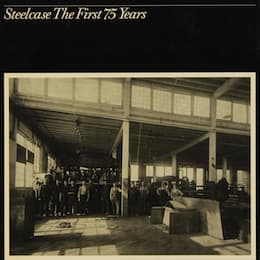
on eBay
or
Amazon
or
AbeBooks
(affil link)
Q. I recently got my hands on an old (50's-60's era) Steelcase-type desk/table. It's in decent shape-workable, but dinged and dirty. I want to restore it to it's former (but updated) glory.
I have sanded off the original paint and coating (whatever that coating was), and I am now down to the bare steel (which is really nice, by the way). I'd like to keep this bare metal look. The sanding left behind a "swirly" pattern in the metal, which to me doesn't look bad. I'm curious what others think of this look.
Should I put some type of a coating over the bare metal? What would you suggest to protect and keep it shiny/glossy? Also, if I get a bunch of gagging over the swirly metal, how would I get the pattern out of the metal (it's only a surface pattern--maybe would buff out if necessary?).
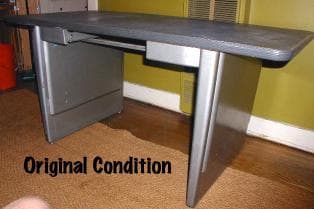
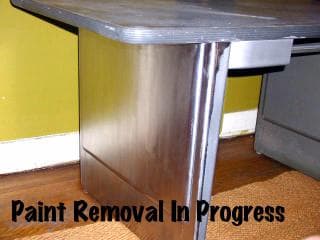
Also, the desktop is tragic. It's a linoleum, I believe, and has seen too many hot coffee cups, cigarettes and box cutters. It was suggested to me that I simply replace the linoleum, but I am curious of anyone has another suggestion that might look better. The trim around the desktop--I think I can save that, but in case I screw it up. do you know of a resource for replacing it? It is a rubber molding, with a metal strip between the molding and desktop. Anyone know of any good how-to books that might cover the entire process I am trying to do?
This is a new area for me, but I am very eager to make this piece beautiful, so I appreciate any direction or suggestions.
artist/graphic designer - West Hollywood, California
2003
Q. I have recently acquired several pieces of vintage steel office furniture. I would like to strip the ugly gray paint, polish the steel and clearcoat it. I need suggestions on the best method for removing the paint, polishing the steel and then the best clearcoat for the top. Any suggestions would be greatly appreciated.
Thanks!
- Denver, Colorado
2004
A. To Todd and Kelly, from another vintage metal furniture devotee: The May 1999 issue of
Martha Stewart Living has a good article about restoring vintage metal furniture, with a few before and after photos. That article says you can use rubbing compound
⇦ on
eBay
or
Amazon [affil link] and a coat of wax
⇦ on
eBay
or
Amazon [affil link]
to spruce up the existing paint and put new glides on the legs, rollers on the drawers and install a new top surface. If you choose to change the color of a piece, according to the Martha Stewart article, you can choose to have your metal furniture wet-coat painted (this is done at an auto-body shop with a high-powered spray gun) or powder-coat painted (involves applying a very fine, dry pigment to an electrically charged object and then baking it in a large oven). Before either method can be used, a professional should strip the old finish by bead-blasting it with tiny plastic pellets, according to the M.S. article. Most of the pieces shown in the Martha Stewart feature were wet-coat painted...the article says it is cheaper to have several pieces done at once - the furniture must be disassembled and the nonmetal parts have to be masked first. For powder coating, the glides, rubber bumpers and other nonmetal parts must be removed so they don't melt in the oven. The Martha Stewart article says powder coat painting is the cheaper method, but the choice of colors is more limited and it might take some persistence to find a painter who will work on an individual piece.
I just found an old Steelcase desk at a garage sale and hope the Martha Stewart tips work out! (I'm not positive, but I think those tips may have been provided for the article by a company called Past Present Future in Minneapolis.)
- Palmer, Alaska
This meeting place welcomes Q&As, photos, history, & interesting tidbits.
Please engage with other posters
• When people show interest in each other's situations, the page quickly becomes a fun & informative learning experience for everyone !
• When people show no interest in other people's postings, and just post their own, it often quickly deteriorates into a string of unanswered questions 🙂
Q. Hi, all. I took the leap and bought a 1950s Steelcase tanker desk. Happily, the linoleum top is in great shape, and there aren't too many dings/dents in the metal. I did my homework, read all your suggestions in this forum, read the Martha Stewart article (which is available on the Past Present Future Web site via .pdf scan) and took the desk to a local auto body shop. Shockingly, it would cost $1350 to bead blast it, get the dents out and repaint it! Breakdown: $200 for the blasting/stripping, $400 for the dent removal, $700 for the paint process. Needless to say, this is unaffordable!
I have no idea what to do. Should I spend $200 to have it blasted professionally and then try to coat/paint it myself (which poses obvious issues with the potential rust, etc.)? Is there a way I can get the dents out myself (Bondo
⇦ on
eBay
or
Amazon [affil link]
? Hammer?) and then sand it down lightly and apply a metal paint to cover the two layers of paint already on there?
Any suggestions/ideas? I noticed that one contributor is from Denver... Where did you have yours painted a few years back?
Now I know why Sonrisa charges $1800 for refinished tanker desks just like mine. It's a fortune to redo them!
Any advice would be appreciated... Thanks!
⇐ answer?
- Denver, Colorado
2005
Q. Hi everyone. I am looking for information on how to remove the linoleum top from my Steelcase desk (40s/50s). I have been in brief contact with Past Present Future on tips about cleaning up the top with special heavy duty cleanser (and I have read the Martha Stewart article), but unfortunately it looks like we're going to have to replace this. anyone know how to go about removing the top without damaging anything. we've already got the replacement linoleum -- a company here in Sweden sells desktop linoleum in pretty vintage colors. Thanks! ⇐ answer?
Emily Tanner- Stockholm, Sweden
2006
Q. Emily, I have a business in Pittsfield, MA that specializes in restoring these Tanker desks, as well as other Mid-Century metal seating and lighting. Can you please let me know the company that carries the linoleum in Sweden? It would be very helpful if I could expand the color options for these desk tops.
Thank you,
- Pittsfield, Massachusetts
2007
Ed. update: Please see Ted Mooney's reply from 2025 for two domestic sources of the linoleum; but it seems to only be available in gray.
Q. Can anyone provide the Martha Stewart article from May 1999 regarding restoring vintage metal furniture that a previous reader wrote about? I just acquired a steel tanker desk for free! that is in pretty good shape. I just want to clean it up from top to bottom without doing any damage to the existing paint and further protect it. Any suggestions would be helpful.
⇐ answer?
Thanks>
- Glendora, California
September 20, 2008
Q. My question is a bit off the mark, but it seems like all these tanker desk owners might be able to help. My father is closing his business and needs to sell the office furniture. I have just this evening learned that at least three of his desks are "tanker" desks. I'd like to learn about the history of this style of furniture. Any suggestions? Does the Martha Stewart article discuss the history and manufacturers? ⇐ answer?
Kathy Doig- Mason, Michigan
April 26, 2009
Q. I'm looking to refinish an old 50's to 60's office desk with a brushed look on the sides, and the top with a swirled look, I've seen a few of them on eBay , can anyone tell me how to do this? I have a very deep mechanical background, so lay it out there :)
Jeff SwopeStudent - Grapevine, Texas
2004
A. Hi all. I would suggest that you take a piece of scrap, polish it quickly, clearcoat it and see how rust-free it stays in your particular environment first.
Please consider that if you look at really top-notch paint jobs such as on a car, they involve first dipping the steel in molten zinc (the galvanneal process) so the surface is now zinc rather than steel, then phosphatizing it (which is a process that converts the surface of the steel to a toothy finish for good paint adhesion, while relieving corrosion hot spots that are caused by mechanical working) and providing protection against corrosion at any tiny pinholes. The phosphatizing is dull, matte, and opaque. Then the metal is dipped into an electrocoating tank to be primed with a colored primer (this gives coverage in the joints and folds and spot welds where sprayed, brushed or powder paint can't reach and where moisture accumulates by capillary action and rust tends to seep out). Finally, two of more layers of spray paint are applied in a room from which the dust has been filtered, and which is humidity controlled; then the paint is baked -- all before the clear coating layer. The reason for all this effort is that steel rusts quickly and easily upon exposure.
Now, for interior use you clearly don't need an auto-quality job, but ...
Although "brushed steel" is a very fashionable look today, to have the steel show through like that requires that there be no galvanneal cathodic zinc coating, no phosphatizing to fight galvanic hot spots, and no electrophoretic prime coating on the steel to protect it from rusting at the joints and folds, and no paint -- in brief, it requires that all of the proven tools against long term rust prevention be thrown out the window, and only a layer of clear lacquer or clear coat paint stand between the very active steel surface and the atmosphere.
That's why appliance manufacturers use stainless steel rather than plain carbon steel with a clearcoat for brushed metal kitchen appliances.
I note this not to discourage you from your hobby, which I wish you well with! But before putting a huge amount of man-hours into an effort, you should know your odds of it staying rust-free. If the house is air conditioned, and cool & dry, and away from the ocean it should be okay for several years. But good environmental conditions are required: in a damp basement or a garage location and it may not hold up for long.
Scratch brushing is actually done with a quick "SCRITCH!" from a large belt sander (called a Timesaver), not a metal brush. There are also a lot of different swirled patterns, from a 'dowel' or 'jeweled' finish to larger patterns that can probably be done with sandpaper or scotchbrite on a circular buffer or a
Dremel
⇦ on
eBay or
Amazon [affil link] . Good luck with your projects!

Ted Mooney, P.E.
Striving to live Aloha
finishing.com - Pine Beach, New Jersey
Ted is available for instant help
or longer-term assistance.
![]() Ted,
Ted,
Thanks so much for replying to our inquiries. I am so glad that I found out now that this project is not a good idea -- at least if I don't want rusty furniture! Now that I know how this is done I probably would never buy any pieces that were done in this manner either. I will just have the pieces I have collected sent out to be painted. I had my desk painted several years ago by a car painter and it looks wonderful- with no rust!
- Denver, Colorado
Ed. note: Again you may get by with just a clearcoat in a very benign environment, but a proper paint job is far more robust than a clearcoat.
! An outfit called Modern Masters (a faux finishing company) have a clear acrylic called
>Master Clear that is often used on polished/brushed aluminum and other metal surfaces such as elevator doors, etc.
D Marcus
- Valencia, California
2005
A. Hi, D. Thanks. Yes, there are many good clearcoat materials available. Readers may be interested in listening to our podcast interview about clearcoating with Teresa Sedmak, president of Everbrite Coatings. But plain steel is quite different from aluminum surfaces and brass or stainless steel elevator doors. Plain steel needs far more protection from rusting. A cool, dry, air-conditioned office is one thing, and brushed steel with a clearcoat may be okay there; but maybe not in an 'office' in a damp basement.
Regards,

Ted Mooney, P.E.
Striving to live Aloha
finishing.com - Pine Beach, New Jersey
Ted is available for instant help
or longer-term assistance.
A. I just got a steel desk sanded and painted at an auto body shop. The desk was in relatively good shape so there was not a huge amount of fine work needed. For me, the key was finding a small company run by an independent contractor who was willing to do it at an affordable cost. I bought the desk for $10 at our local university recycle shop, and the total cost for sanding and painting (with BMW paint -- tee hee hee) was $252. It is beautiful. So my advice is to call around and find someone who needs the business. Good luck!
Beth Graue- Madison, Wisconsin
Table Protectors
hard or soft
24" x 48" & other sizes
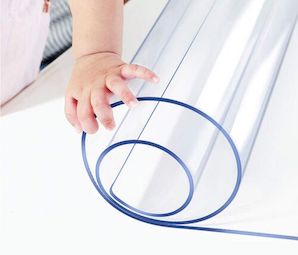
on eBay or Amazon
(affil link)
Q. I'm restoring a 1950's Steelcase desk. I want to replace the current linoleum top, but I can't figure out how to remove it. (Is it glued down?). Where might I find linoleum if I can remove the top?
Scott Bremer- Atlanta, Georgia
2005
Ed. update: Please see Ted Mooney's reply from 2025 for two domestic sources of the linoleum; but it seems to only be available in gray.
Q. I have a desk with a laminate top; does anyone know how to get it off, it's glued to the steel behind it?
Mike Allisonhobbyist - Roseville, California
March 8, 2009
![]() I answered my own question about removing the laminate top from the desk. I used a putty knife and a hammer and gently tapped the knife between the laminate and the steel. I got it all removed without damaging the metal beneath.
I answered my own question about removing the laminate top from the desk. I used a putty knife and a hammer and gently tapped the knife between the laminate and the steel. I got it all removed without damaging the metal beneath.
hobbyist - Roseville, California
Q. I have my grandfather's STEELCASE desk that I want to restore. I plan on taking the metal portions to a body shop for painting but the top of my desk is not linoleum. It is some kind of soft black substance that is dented from years of use.
Does anyone know if this can be removed/replaced?
Thanks in advance,
- Lafayette, Louisiana
2007
A. Lawrence A., what you have is the laminate top. It's soft and rubbery, while other tops for these tanker desks are hard, similar to kitchen counter tops. My laminate top is peeling back in one of the corners, it's about 1/4 inch thick. I have yet to remove it completely, but its only glued down.
Here's my flickr page with photos:
www.flickr.com/photos/tanker_desk/
- Grand Rapids, Michigan
![]() Jeremy,
Jeremy,
Thanks for responding to my request. Your desk in process looks very nice. I hope to get mine to that point one day. The shape of my top is different in that the edges are rolled down and the corners have these somewhat ornate metal pieces on them. It gives the desk top a different look, not as flat, and it makes the laminate appear thick. I guess it is a different era of desk. I don't know the age of mine and haven't found any indication on the desk itself.
Thanks again,
- Lafayette, Louisiana
A. Sounds like you have an Art Metal or possibly a Shaw-Walker brand desk. Those are definitely in the same era, just a different manufacturer. Check here for some great photos:
pastpresentfuture.net/examples/desks.html
Not sure what I would do about that top. I've seen some people completely replace the top all together and place a nice wood butcher-block style slab on top. I've also seen a nice piece of glass placed over worn out desktops.
Good Luck!
- Grand Rapids, Michigan
Q. I have acquired a Steelcase desk that has lost most of the drawer rollers. The one I could find is an off-white plastic that has an outer diameter of 1", an inner diameter of 5/32", and a thickness of 5/32". One side of the axle hole is covered so that installation on the roller peg is from one side only. These rollers fit on pegs attached to the desk rather than the drawer. Any idea where I can get more rollers?
Thanks.
- Idaho Falls, Idaho
2007
A. I have refinished, several desks, fridge, steel case shelves...by hand. It can be a lot of work but its cheaper than having it professionally done. I don't care for the brush look. I like the
To remove the old paint use Aircraft Stripper. With an industrial brush apply it in the same direction. (wear rubber gloves
⇦ on
eBay or
Amazon [affil link] , protective clothes and mask and goggles
⇦ on
eBay or
Amazon [affil link] , do it outside. The stuff is intense)
- Leave it on, scrape it and apply as many times needed to remove the paint. Take 00 steel wool
⇦ on
eBay or
Amazon [affil link] , brush or scraper, and remove the rest. Be careful not to scratch it too much (it's messy)(I use the blue metal spatulas for Venetian plaster)
-At this point either you stop, or have to finish it. As it is the metal will oxidize. If you stop, there will be a little work in removing some of the oxidation, when you start again.
-wipe it down, with a metal cleaner.
-Then take Silicon Carbide paper (wet/dry sandpaper) (takes a lot), start with a 220-2000 grit . I got old gloves and stuck the paper on them. If there is a "grain" or machine marks , start by going against them, then other direction, then against again. Sand this way until they disappear. Continue on to the next grade sandpaper.
Same thing all over again. Repeat this until you've moved through all the grades and have a nice shiny surface.
I only go in the same direction, to achieve a smooth finished look with no pattern.
Use your own judgment when to move to the next grade.
You will have to apply some top coat, wax or paint to keep the metal clean and shiny. Immediately.
If you want to keep the piece raw, finish by using metal polish (by hand or buffer). Then cover with wax, I used butchers). If you use wax, there is maintenance involved...you will have to reapply, every so often...it's work!
If you want to put a coat on it I recommend an epoxy based metal paint (hard to find, specialty paint places carry them) or one from the auto department. The epoxy is the best. The auto body paint on the shelf is similar to spray paint. It looks good if you take your time and apply it evenly.
You need:
Aircraft Stripper
protective wear (gloves, eye, face)
Silicon Carbide paper 220-2000 grit (several grades)
sanding block or 2x4 cut
00 steel wool
⇦ on
eBay or
Amazon [affil link] , brush, scraper
a Dremel
⇦ on
eBay or
Amazon [affil link] is great as well.
metal cleaner
metal polish
rags or buffer
top coat- wax or epoxy
It's a full day or more depending on piece, the application of initial paint (baked on is hard).
- Vancouver, BC, Canada
Ed. note: In the intervening years since this was posted, aircraft stripper (methylene chloride) has become pretty close to unavailable due to its great toxicity. If you're going to get it and use it anyway, remember goggles ⇦ on eBay or Amazon [affil link] and gloves ⇦ on eBay or Amazon [affil link] as a minimum, plus very good ventilation -- preferably outdoors.
Q. Hello,
Does anyone have any advice on refinishing a 1954 RCA metal cabinet from a radio station: The original finish looks like a gunmetal grey metallic baked lacquer finish with a clearcoat with what look like mottled or 'dimpled' surface inflections.
At the moment, there is a bad black spray paint finish. The original finish is visible on the inside surfaces.
⇐ answer?
Thanks,
Marty
- Vancouver, Canada
2007
Q. Does anyone have a step by step video or CD how to restore desk?
Marco Lugohobbyist - Denver, Colorado
March 11, 2008
A. I have restored at least 10 tanker desk and tables. Firstly if the old finish is still good with no rust, and no chipping; do not strip it. The baked on OE finish makes a good base for the new paint. If this is the case, disassemble, using an Air Powered DA (dual-action) simply knock down the old finish, do not sand through to the metal. Once you you have the surface sanded paint with automotive paint, clear, wet sand and buff. I found a local shop that will paint and clear for $150-200. I will finish the wet sanding and buffing, which only takes about 2 hrs.
If the OE paint is damaged have desk bead blasted, and powder coated. Check Local industrial powder coating shops. I have a shop that will bead blast and coat for under $200 on most desk and tables. Having done my first few desk the old fashioned way (lots of elbow grease and massive amounts of time), bead blasting and coating is by far the most economical.
- Youngstown, Ohio
Q. To those who have refinished tanker desks: Can most of these desks be disassembled for easier stripping & painting, not to mention transporting? Especially, removing the top. The powder coat company I contacted said the top (orig. "rubbery" black, laminate) cannot withstand the 400 degrees necessary for this finish. Thanks. ⇐ answer?
Janice Parkshobbyist - West Tisbury, Massachusetts
September 10, 2008
Q. I have a steel 50's vintage reading table. It has the linoleum type top. I recall back when I was much younger you could pour a liquid chemical on the top of the desk and it would dissolve the top at which point it would re-solidify back to its original good finish with no dings or dints. Does anyone know what this chemical is?
Joe
- Birmingham, Alabama
March 1, 2009
A. As far as getting a brushed look on steel it can be done. I have been an automotive painter for 13 years and have done many successful finishes on brushed steel. When you sand metal that is what paint/clear coat sticks to. That is how automotive painters do it every day! When you stripped the paint off you didn't sand through the galvanized layer. It will not rust if there is ample clear coat on the piece.
As far as the rubbery top on the tanker desks, I have just used wedges, screwdrivers, or anything thin and ripped the top off. Once you get it going it should come off with ease. Then remove any excess glue and get the metal top of the desk as smooth as possible. I then take 1/8 press board with a very smooth finish on top and fit it to the desk top. I prep it for painting and then give the finishing color and making sure that you seal all the edges of the press board. If you do not then the press board will separate.
- new orleans Louisiana
A. Hello,
Forbo Nairn in Kirkcaldy produce very nice furniture linoleum for desk top type applications.
www.forbo-flooring.co.uk is a useful link and you can contact them for USA suppliers.
This is not just an ad - I was looking up furniture and lino-topped desks on Google.
Old furniture restoration is real work...
Regards,
Andrew
Accountant - St Boswells, Roxburghshire, Scotland
(you are on the 1st page of the thread) Next page >
Q, A, or Comment on THIS thread -or- Start a NEW Thread

